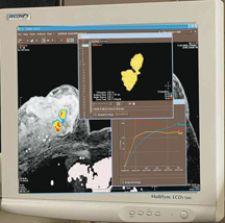
\"A role for CAD is to assist with the data overload of CT slices,\" agreed Topher Gedeon, senior software engineer, iCAD.
An integrated RIS/PACS, clinical applications and enterprise-wide access to the electronic health record (EHR) promise to increase a radiologist’s productivity and enhance efficiency by automating radiology workflow. Information technology (IT) is also viewed as one of several answers to the continued radiologist shortage. However, many facilities have yet to realize the full potential of IT as the result of not fully addressing workflow changes when a facility moves from a film-based to a digital environment, and consequently have not seen a positive effect on radiology workflow.
RIS/PACS Integration
The rise of integrated RIS/PACS is in direct response to the inefficiencies created by the historical separation of information and images. While many vendors’ solutions integrate data, the real challenge is to implement a single back-end, unified database of patient images and data. “PACS is only one component,” said Rich Linden, president, Merge Technologies. “Integrated RIS/PACS with a seamless workflow is key.” Linden added that the release of FUSION RIS/PACS MX was designed with input from customers to replicate radiology best practices workflow. “Today, the integration of clinical applications, including specialty imaging tools, along with RIS/PACS will accelerate productivity. Radiologists must have advanced clinical applications to further change workflow,” Linden explained.
While Robert Cooke, executive director, Marketing, FujiFilm agrees that bringing data together is important, he also notes that workflow must encompass the entire process, from scheduling to reporting. Fuji’s works-in-progress Synapse Comprehension is designed to address all aspects of the radiology department – from processing to reporting – while merging data in a way that will enable the creation of a single and complete intelligent system in place of separate RIS and PACS.
The future of efficiency gains, believes Lenny Reznick, director of Enterprise Image Management Solutions, Agfa Healthcare, will come about as the result of adoption of enterprise workstations that will “marry images and information in a manner that is efficient, effective and broad reaching,” said Reznick. “The explosion of information available to healthcare providers necessitates inherent designs within the workstation that focus the user on information specific to their roles.” The release of Agfa's Impax Enterprise will reportedly “integrate with the clinical portal to help make radiologists more productive and powerful,” indicated Reznick. In addition to the “marriage of information and images,” he envisions the clinical adoption of “persona-based workflow.” This concept relies on one user interface with different persona-based workflows based upon the clinician's role. Reznick explained, “The explosion of information available to healthcare providers necessitates inherent designs within the workstation that focus the user on information specific to their roles.”
Remote Access Drives Workflows
Web portals are also an important feature, enabling referring physicians or off-site radiologists the ability to securely access information, thereby extending the reach of the enterprise. In addition to workflow issues, Cooke sees the shortage in radiologists driving the adoption of informatics in radiology. “The radiologist shortage will force a model where radiology is delivered across a wide geographic area,” said Cooke. Advanced Web technology coupled with integration capabilities will enable access to the EMR and other “intelligent applications” through a portal, Cooke added.
In response to the growing need for remote access, GE Healthcare recently launched an intelligence portal for radiology administrators. With GE’s Centricity Radiology Business Intelligence Portal, administrators receive real-time feedback on equipment utilization, exam status, department performance and patient wait times. This information can then be used to adjust processes to maximize department efficiency and enhance workflow. The solution was developed in response to customers “in need of a solution for common service and workflow issues,” explained Vishal Wanchoo, president and CEO, GE Healthcare Information Technologies.
Eclipsys’ newest release of Sunrise RIS provides a dashboard view of all of a patient’s clinical data, structured reporting or digital dictation and the ability to annotate diagrams and key images for inclusion in the final radiology report. Andrew Eckert, Eclipsys’ president and CEO, noted that “[w]hen combined with Sunrise Clinical Manager and Sunrise PACS, healthcare organizations have an image-enabled clinical information system for the full organization… this powerful combination reduces the potential for errors, and strengthens the ability to provide optimal care while rapidly reducing operating costs.”
EHR Sets Standards
In the near future, terminology such as RIS and PACS will remain, but slowly become inconspicuous as the push for a national EHR continues. According to Henri “Rik” Primo, director, Marketing and Strategic Relationships, Siemens Medical Solutions USA Inc., “We see actually a strong trend where every healthcare provider will have access to the EHR through their desktop PC or portable device to perform their daily activities. In this world, PACS is the source of imaging information to the EHR, and RIS is the workflow engine for the radiology department. The EHR replaces the paper notes, folders and film jackets. Care providers will live in an electronic, geographically distributed but tightly integrated enterprise in an atmosphere of clinical excellence, research and education.”
Alex Jurovic, CEO, Dynamic Imaging, agrees that the integration of PACS into the EHR is a natural progression. “We need to look at the EHR as a workflow tool — an ability to collect information and present it in one integrated view,” Jurovic said. Most important to Jurovic is the continued commitment to supporting standards such as DICOM and the IHE profiles. “As we move forward and dovetail into these broad nationwide, regional health initiatives, transparent systems are necessary,” emphasized Jurovic. “Systems that don’t adhere to industry standards for communicating medical information between systems or modalities cannot coexist in this complex environment.”
CAD and 3-D Affect the Flow
Beyond the EHR and IT solutions, clinical applications such as computer-aided diagnosis (CAD) and 3-D processing/advanced visualization will impact radiology workflow. Dr. Farhang Daemi, director of Client Services, MedicSight, believes that “CAD will become commonplace. [Radiologists] need intelligent tools available to address repetitive tasks.”
“A role for CAD is to assist with the data overload of CT slices,” agreed Topher Gedeon, senior software engineer, iCAD. Gedeon also envisions that in the near future, PACS will embed CAD and function in a similar manner as today’s mammography workstations.
“CAD products will continue to assist in diagnosis and thereby positively impacting workflow,” stated Shawl B. Lobree, vice president of Marketing, R2 Technology. Lobree noted that CAD could act as a first reader and help prioritize workflow based upon those results.
3-D visualization software is also emerging as an enterprise-wide solution, aimed at facilitating the use of software to create a more efficient workflow for large volume studies such as multislice CT. Carter Yates, senior director, Strategic Marketing, Voxar Product Group, Barco, said, “It is now practical to conduct 3-D with each CT exam – the technology has become a mainstream technique.” Vital Images also released its latest enterprise-wide advanced visualization package, further underscoring the importance of access to these tools to enhance workflow.
The integration of digital images, advanced clinical applications and electronic data into an enterprise-wide PACS holds much promise for increasing radiology efficiency. These tools will address issues in workflow that have hampered radiologists’ ability to work more productively by ensuring the availability of patient information and images wherever and whenever needed.



 June 28, 2024
June 28, 2024 









